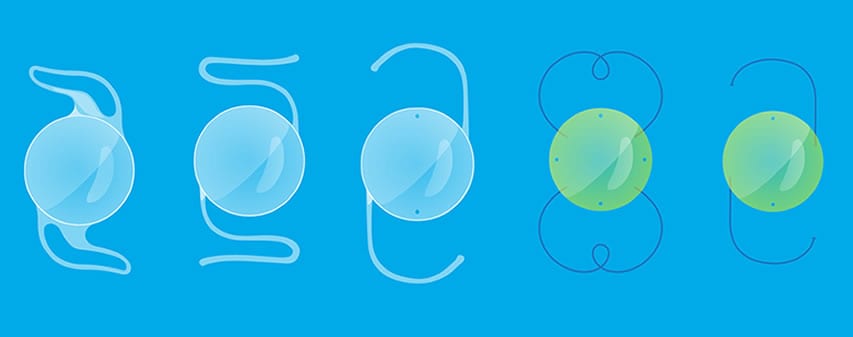Intraocular Lenses (IOLS) in Everett, WA
What Are IOLs?
An intraocular lens, or IOL, is the artificial replacement lens implanted when a patient’s natural lens has been surgically removed during cataract surgery. A wide variety of replacement lenses are available to cataract patients, each offering its own advantages for post-surgery vision. The most effective lens to use depends on the patient’s preferences and particular vision goals. Goals for vision differ according to individual occupations and lifestyles. IOLs often eliminate the need for glasses or contacts after cataract surgery, conveniently providing most patients with clear vision.
Who is a candidate for IOLs?
Intraocular lenses (IOL) are an integral aspect of cataract removal surgery. These artificial lenses are ultra-thin and are often made with specific accommodating factors that restore the clearest possible vision. If you need cataract removal surgery, you will get an intraocular lens that is best suited to your needs. An additional reason to get an IOL is as a part of refractive lens exchange surgery. This procedure is performed as a long term solution for presbyopia, farsightedness, and nearsightedness.
Is the IOL implantation painful?
In most cases, there is no pain involved in cataract removal or other lens replacement surgeries. Before beginning the procedure, the doctor administers anesthetic eye drops which numb the ocular surface. These may be inserted once or more during the procedure to maintain comfort. Patients may also receive a mild sedative to help them feel comfortable and relaxed during their brief procedure.
How can I prepare for my IOLs?
During the presurgical exam and consultation, the ophthalmologist may make specific recommendations based on the particulars of the case. Generally, patients are advised to stop wearing contact lenses days before surgery. They may also need to start using artificial tears several times a day, and may take a fish oil supplement to help prevent dry eye symptoms related to the procedure.
What is the recovery involved with IOLs like?
Patients may need a day or two to fully recover from their lens replacement procedure. During this initial period, vision may be somewhat foggy or blurry. The eyes may feel gritty and sore. These symptoms improve significantly over the course of a few days. Slight swelling may be noticed but is not painful. It is also possible to notice tiny red spots on the whites of the eyes. These are only temporary and will resolve as inflammation decreases.
Multifocal Intraocular Lenses
Multifocal intraocular lenses are designed to correct vision at varying distances. They are appealing to individuals who would prefer not to require eyeglasses or contact lenses after surgery, or to require corrective lenses only for certain activities.
How long do multifocal lenses last?
Intraocular lenses are implanted into the eye in the same capsule that holds the natural lens. Once healed, which takes 1 or 2 days, this capsule holds the IOL securely for long-term visual acuity. The material from which the IOL is made is crystal clear and does not break down over time the way the natural lens of the eye does. This means that this new lens could last indefinitely, never requiring replacement.
How Do You Know if You Need an Intraocular Lens?
If you have cataracts and decide to have them removed, the process involves removing the natural lens of your eye. You will need an intraocular lens to replace this. An additional reason to receive an intraocular lens is to achieve long-term correction of a refractive error like presbyopia, nearsightedness, or farsightedness. In this situation, the ophthalmologist may perform refractive lens exchange using an intraocular lens that features the appropriate lens shape and magnification to optimize your vision.
How Do IOL Implants Work?
Your intraocular lens is selected based on your current vision and goals. This new lens takes over for the natural lens that has been removed. Its function is to receive light as it comes into the front of the eye and direct it to the retina at the back of the eye in a focused manner. The retina transforms the rays of light that land into signals that flow through the optic nerve to the brain. There, the signals are interpreted and formed into images. By focusing light efficiently to the retina, an intraocular lens can improve a variety of vision errors.
How is IOL Implantation Performed?
Cataract removal and lens exchange are somewhat similar in the way that they are performed. To replace the natural lens, the doctor makes a small incision at the edge of the cornea. Through that, they perform phacoemulsification, a process that breaks the lens up into tiny pieces that can then be easily flushed from the eye. The new lens, the malleable IOL, is folded and inserted through the incision. It is positioned in the same capsule of tissue that held the natural lens. There, it is unfolded and positioned properly to restore your vision. The procedure is performed while your eye is numb from a topical anesthetic. You should not feel any pain, only slight pressure.
What Type of Results Can I Expect?
Having an IOL after cataract removal, you can expect colors to appear brighter right away. As you adjust to your new IOL, your vision will transition from blurry to clear at most if not all distances. Depending on the reason for your lens exchange, you may still need to use eyeglasses to read or to improve distance vision. When you consult with one of our doctors, you can expect a thorough consultation and examination. This will allow the doctor to make the best recommendation for the lens option or options that would be ideal for you.
Are There Side Effects from IOL Implantation?
Yes. The most common side effects that occur after IOL insertion include dry eye, discomfort, blurry vision, and sensitivity to light. These are expected to resolve in one to two weeks. Your vision should improve gradually day by day until your side effects disappear.
Are Intraocular Lens Implants Safe?
Intraocular lenses have been a part of cataract surgeries for decades. Few serious complications occur among the thousands of procedures that are performed each year. While any surgery has a chance of complications, the risk is quite low for lens implant procedures. The most common side effects are swelling and redness. There is a slight chance of infection or bleeding, both of which can be reduced by following your post-op care instructions. Very rarely, a complication such as retinal detachment, IOL dislocation, or a secondary cataract may occur. A secondary cataract is the clouding of the capsule of tissue that holds the new lens. With prompt attention, more complications can be corrected.
Can each eye have a different Multifocal IOL?
In some cases, an ophthalmologist may prefer to use two different multifocal IOLs, one for each eye. This is recommended with the utmost caution and vision for the bigger picture. Because different multifocal lenses may refract light in a particular way based on the way that “zones” are arranged on each, it may be possible to achieve an expanded range of vision. Using different IOLs for each eye is not a widely practiced method. It is reserved for specific situations as seen appropriate based on a thorough consultation and eye exam.
While recovering from lens replacement, patients should:
* Use prescribed medication as directed.
* Insert eye drops as instructed.
* Always wash hands with soap and water before applying eye drops.
* When sleeping, wear the protective eye shield applied after the procedure.
* Expect to be drowsy for several hours after the procedure.
* Avoid rubbing the eyes or squeezing the eyelids
What happens if I need my Multifocal Lens removed?
An intraocular lens may be removed and replaced, but this is very rare. There are only two reasons why an ophthalmologist may consider doing so. One is if the lens has shifted from its original position. This situation is very rare and, if it does occur, does so spontaneously. There are no steps that can be taken to prevent it. If vision changes after getting an IOL, the patient should schedule an eye exam right away. Another reason that an IOL may be replaced is if it does not have the right power. Ophthalmologists are very careful in their calculations when planning treatment and yet, there are rare instances in which the patient’s vision is not as expected after surgery. IOL replacement can be done but carries inherent risks, so the ophthalmologist is extremely discerning when considering the value of this procedure for any patient.
Tecnis® Multifocal IOL
The Tecnis Multifocal IOL can also be used for those patients with or without presbyopia who want to have near, intermediate and distance vision without relying on glasses or contact lenses.
Designed to provide cataract surgery patients with a high-quality vision similar to that of a younger person, the Tecnis IOL improves functional vision, the ability to see objects in varying light conditions, especially at night, at twilight, and in rain, snow or fog. It provides improved night vision and a reduction of spherical aberrations (scattering of light), a common side effect of cataract surgery.
Unlike other multifocal IOLs, the Tecnis Multifocal IOL provides the following benefits:
- Excellent vision at all distances
- Excellent vision at all light levels
Approximately 90 percent of patients using Tecnis Multifocal IOLs do not require reading glasses.
Each type of multifocal IOL has its advantages. The ophthalmologist, in consultation with the patient, will decide which IOL is appropriate in each individual case.
Acrysof® IQ Toric IOL
Intraocular lenses are used during cataract surgery to replace the damaged lens of the eye with an implant that clears up and corrects vision, oftentimes leaving patients with little to no dependence on glasses.
Up until now, patients with astigmatism did not have the same opportunities that other cataract patients have had in correcting their condition with the types of IOL lenses that were available. Typically, the astigmatic patient would need an additional surgical procedure, such as refractive surgery or LASIK, to correct their vision after the procedure. If the patient did not want to undergo another surgical procedure, the only option for correction would be the use of either contact lenses or glasses to address their astigmatism.
Toric IOLs are able to accommodate for the condition of astigmatism. Toric IOLs are specially designed to correct astigmatism along with overall vision during cataract surgery, offering complete vision correction.
The advanced Toric IOLs correct the imbalance caused by an irregular cornea shape in patients with astigmatism. There are several different types of FDA approved Toric IOLs which can correct up to 3 diopters of astigmatism.
The Toric Iol Procedure
The cataract-impaired lens of the eye is gently removed through a tiny incision that is made on the edge of the cornea. The lens is then removed and replaced with the Toric IOL. The procedure takes from 15 to 45 minutes to complete.
Following the procedure, patients will be able to return home after about an hour of observation. A follow-up appointment is usually scheduled for the day after the surgery to monitor the patient’s recovery. Recovery from the surgery is usually short, and most patients are able to return to their normal activities almost immediately.
There may be some itching, discomfort and sensitivity to light after surgery, which can be managed through eye drops that have been prescribed by your doctor. These symptoms usually go away within a few days as the eye heals and patients can begin to enjoy the many benefits of their new lens.
Risks & Complications Of a Toric IOL
As with any surgery, Toric lens surgery has potential complications. The most common side effects of all cataract procedures include:
- Redness
- Irritation
- A sensitivity to light
- Infection
These risks, however, are rare and are often outweighed by the potential benefits of restoring vision.
Complications specific to Toric IOL may include:
- The lens rotating out of position
- Loss of sharpness of vision
Toric IOLs are considered safe for most patients with astigmatism and are the only solution to correct vision problems associated with both cataracts and astigmatism.
Schedule a Consultation Today!
To learn more about Intraocular Lenses and whether they are right for you, please book a one-on-one consultation with one of our top ophthalmologists. Call (425) 259-2020 or click here to fill our Consultation Request Form! Our practice is located in Everett, WA, and we look forward to serving you!




